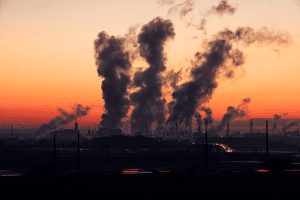
What the EU’s Carbon Border Adjustment Mechanism Means for Europe and the United States
5 min readBy:Today, the European Council gave final approval to the world’s first Carbon Border Adjustment Mechanism (CBAM). Well, in name anyway.
The mechanism is a key aspect of the EU’s broader Fit for 55 package which aims to cut 55 percent of net greenhouse gas (GHG) emissions in the EU by 2030. It’s also a foundational aspect of the Commission’s new own resource proposal to fund EU budget initiatives.
In 2005, the EU implemented a domestic carbon pricing mechanism called the Emissions Trading System (ETS). This cap-and-trade mechanism sets a cap on the amount of emissions that are allowed to be expelled into the air by firms. The market price of carbon is then set by “cleaner” firms trading allowances with more carbon-intensive firms. To protect the competitiveness of European industries that produce carbon-intensive goods, some EU firms are granted “free” allocation of ETS allowances.
CBAM is designed to complement the ETS by placing a carbon price on certain imports into the EU from third countries such as Russia or the United States, which do not taxA tax is a mandatory payment or charge collected by local, state, and national governments from individuals or businesses to cover the costs of general government services, goods, and activities. carbon at an EU-approved level. The goal is to maintain the competitiveness of European producers relative to foreign producers and prevent “carbon leakage.”
Furthermore, the EU hopes CBAM will inspire other countries without a carbon tax to implement their own. Once third countries link their national carbon pricing systems to the ETS, third-country exporters would no longer face CBAM payments.
However, a border adjustment requires two elements. One is a fee charged on imports, and the second is a crediting mechanism for exports. In this case, an EU import fee keeps European products competitive within the EU market while an export rebate is essential for keeping European-produced goods competitive in markets outside of the EU.
Unfortunately, the EU did not approve an adjustment. Rather, it approved a carbon tariffTariffs are taxes imposed by one country on goods or services imported from another country. Tariffs are trade barriers that raise prices and reduce available quantities of goods and services for U.S. businesses and consumers. without export rebates for European producers.
For importers, the agreement puts an import tariff on carbon-intensive products coming into the EU such as iron and steel, cement, aluminum, fertilizer, hydrogen, and electricity; as well as some “precursors” (such as cathode active materials) and a limited number of so-called “downstream products,” such as screws and bolts. Shipping and some indirect emissions will also be in scope.
The price of the tariff will be calculated based on the weekly average price of ETS auctions. By doing so, the price foreign producers will pay for carbon emissions will equal the price European producers pay without the administrative burden of daily calculations.
A phase-in period will take place between October 2023 and December 2025 where importers will be obligated to provide limited reporting data to the EU but will not be required to pay the tariff. As of 1 January 2026, however, importers will be obliged to surrender CBAM certificates for emissions embedded in their products.
For European exporters, things have become more difficult. On one hand, the current system of “free” allocation of ETS allowances will be phased out over a nine-year period, between 2026-2034, with a progressively increasing pace. On the other hand, there is currently no policy in place for export rebates to replace these “free” allowances. Instead, the EU has promised to explore other WTO-compliant ways to prevent carbon leakage on exports.
The EU’s reasoning for not including export rebates is because they would likely violate the World Trade Organization’s (WTO) rules against subsidies. Ironically, the EU opted for a tariff, which is what the WTO (and its post-WWII predecessor the GATT) was principally designed to eliminate. Talk about missing the forest for the trees.
This decision has two main consequences for the EU. The first is it could affect how European producers think about investment. Without a rebate plan in place, some firms may decide the uncertainty is too much to overcome and simply move carbon-intensive production out of the EU. Alternative investment locations could include countries without a carbon taxA carbon tax is levied on the carbon content of fossil fuels. The term can also refer to taxing other types of greenhouse gas emissions, such as methane. A carbon tax puts a price on those emissions to encourage consumers, businesses, and governments to produce less of them. or countries with more beneficial subsidies. A decline in investment would likely slow down economic growth in the long term.
The second consequence is on the EU budget. The agreement makes CBAM administration centralized at the EU-level. As EU Budget Commissioner Johannes Hahn warned in November, “the share of CBAM revenues earmarked for the EU budget will need to be increased, as compared with the 75 percent proposed by the European Commission based on a decentralized governance model.”
This is also important in terms of the NextGenerationEU COVID-19 recovery plan passed in 2020 because both CBAM and Pillar One revenues are supposed to provide a “steady stream of revenue” to repay it. With increasing interest rates, the recovery plan is becoming even more expensive over time. It is unclear at the moment where the EU will come up with more own resources for both unplanned CBAM administration and increased interest payments. This is especially true due to the consequences of the war in Ukraine on CBAM revenue.
For the U.S., CBAM presents economic threats and opportunities. If the U.S. does not pass a federal carbon tax by 2026, American exporters to the EU could face the EU’s import tariff. However, U.S. firms could be exempted if the EU decides that the U.S. has a domestic carbon price akin to the ETS price. It is possible that this decision will be based on a wider political agreement rather than carbon prices.
The growing number of competing climate policies between the EU and U.S., such as tax provisions in the Inflation Reduction Act, could present policymakers on both sides of the Atlantic with the opportunity to work together against economic rivals such as China and Russia. Because free-trade policies are preferred, it is important that the EU and U.S. have tools in their collective toolbox to uphold a rules-based international trade system. However, free-trade and pro-growth policies will suffer if policymakers stick with a protectionist approach rather than finding common ground.
Stay informed on the tax policies impacting you.
Subscribe to get insights from our trusted experts delivered straight to your inbox.
Subscribe
